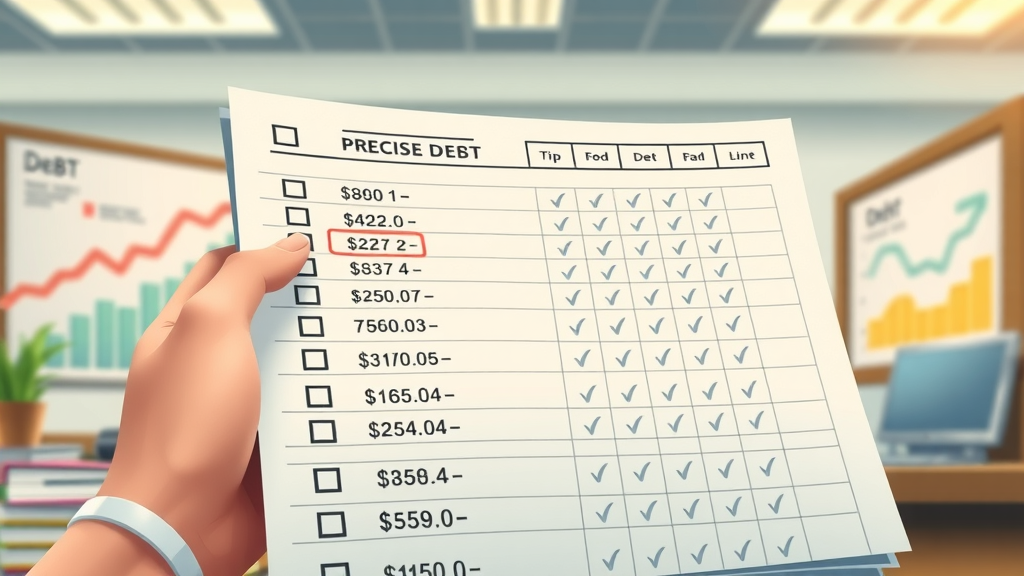Did you know? Over 60% of small businesses fail due to improper debt management—underscoring the vital role a debt schedule plays in strategic financial planning. If you’re not actively maintaining and regularly reviewing your debt schedules, you could be putting your business’s cash flow and future stability at risk. Let’s dive deep into the world of debt schedules, uncover common pitfalls, and empower you with the knowledge to make smarter business decisions.
Are You Overlooking Crucial Factors in Your Debt Schedule?
Creating a robust debt schedule goes far beyond listing what your business owes. Many owners focus only on large loans or forget to include things like credit cards or revolving credit lines. These oversights can distort your cash flow forecasting and leave you exposed to unexpected interest expenses or missed payments. For example, a business that omits short-term liabilities, like supplier finance or business credit cards, may feel surprise pressure on monthly liquidity—especially if these debts carry higher interest rates or shorter repayment terms.
Rushing through or overlooking the details in your debt schedule can also cause you to misclassify types of debt—such as mixing up term debt with revolving credit—or fail to track upcoming principal repayments accurately. In practice, this often leads to budgeting miscalculations and disrupts debt service plans. By systematically checking the accuracy of each debt listed—and updating schedules promptly after each payment or new borrowing—you set your business up for a much clearer financial roadmap. This discipline ensures interest expenses are calculated correctly and every dollar borrowed or repaid is accounted for.

Startling Facts: How Debt Schedules Make or Break Business Outcomes
Did you know? Over 60% of small businesses fail due to improper debt management—underscoring the vital role a debt schedule plays in strategic financial planning.
Debt schedules act as the backbone of financial planning for many companies. Without one, a business can miss changes in interest rates , forget crucial payment dates, or underestimate the impact of debt repayments on available cash flow . For instance, failing to incorporate a new debt tranche or reflect changes in loan terms immediately can skew your cash flow statement, leading to poor fiscal year decisions or unplanned debt obligations. By mastering your debt schedule, you’re protecting your balance sheet and ensuring every repayment supports—not sabotages—your growth plan.
Additionally, using a comprehensive debt schedule helps identify patterns, such as seasonal increases in short-term borrowing or recurring refinancing opportunities. Having this insight lets you proactively manage business debt and develop strategic answers to potential lenders, which can also improve your access to more favorable terms or rates. In summary, the quality of your debt schedule can be a direct predictor of your company’s long-term financial health.
Comprehensive Guide to Structuring a Debt Schedule
- How to identify and avoid common mistakes when creating debt schedules
- Key terminology: cash flow, business debt, interest expense, principal repayment
- How to interpret and use a debt schedule for better financial management
- Examples and templates for practical application
- How to identify and avoid common mistakes when creating debt schedules
- Key terminology: cash flow, business debt, interest expense, principal repayment
- How to interpret and use a debt schedule for better financial management
- Examples and templates for practical application

Understanding Debt Schedules: Core Components and Purposes
A debt schedule provides a clear, organized table of all your business’s outstanding loans, credit lines, and financial obligations, detailing principal balances, interest rates , maturity dates, and scheduled repayments. This schedule is not only foundational for financial statement analysis but also crucial for tracking cash requirements and total debt exposure.
The purpose of a debt schedule extends beyond simple recordkeeping; it’s instrumental in identifying when repayments are due and helps forecast the business’s ability to service debt obligations without disturbing operations. Effective debt schedules are tailored to reflect different types of debt , such as term loans, short-term liabilities, and credit cards, so leadership has a full-picture view of both immediate and future financial commitments.
Defining a Debt Schedule vs. Debt Schedules

While sometimes used interchangeably, “ debt schedule ” in singular form usually refers to a comprehensive summary table outlining all debts for a specific business at a point in time. In contrast, “debt schedules” (plural) could refer to multiple schedules for different business units or time periods, or to specialized schedules for specific types of debt—like those focusing only on term debt or revolving credit.
A single, consolidated debt schedule ensures that management has quick access to critical data for reviews and audits, while using separate schedules can be helpful for larger companies managing debts of different subsidiaries or departments. Regardless of approach, consistent formatting—including columns for principal, interest expense, interest rate, and maturity date—is a best practice to provide easy comparability and support effective decision-making.
Why Every Business Needs a Comprehensive Debt Schedule
No matter your industry, having a complete and up-to-date debt schedule is the key to understanding and managing business debt . Without it, risks like missing a principal repayment or overlooking a balloon payment increase dramatically. This could immediately disrupt planned investments or even threaten your ability to meet payroll.
Moreover, a comprehensive debt schedule exposes potential refinancing needs or opportunities for early payments that save interest expense. It also streamlines preparation for audits and diligence processes, and aligns perfectly with best practices in cash flow management—ensuring that your balance sheet and financial statements accurately reflect the business’s true financial obligations at any given time.
How to Accurately Compile a Debt Schedule for Business Debt Management
Key Data Needed—From Debt Tranches to Term Debt Details

To build a precise debt schedule , gather comprehensive loan data for each debt tranche : lender names, types of debt (e.g., term loan , credit line, lease), principal balance, interest rate , interest expense , maturity date, and any specific payment terms or covenants. Being meticulous here matters—missing out on even one detail can result in an inaccurate representation of your debt obligations and throw off the cash flow statement.
Capturing distinctions between fixed rate and variable rate loans helps anticipate changing interest expenses as economic conditions shift. For multi-tranche loans or syndicated agreements, break out each piece separately so repayment schedules and debt service requirements are transparent. This clarity lets you plan for scenarios—like rising rates or refinancing events—and ensures debt repayments are timed to best fit your business’s operational cash flows .
Step-by-Step: Gathering Loan Data and Credit Lines
Start with your accounting software, recent bank statements, and loan documents. Record every debt instrument, including business credit cards, lines of credit, equipment loans, and any off-balance sheet commitments. For each, document current principal outstanding, original loan amount, accrued but unpaid interest, remaining interest payments , repayment frequency, and fiscal year due dates.
Check for overlooked liabilities—such as supplier financing or deferred payment terms from vendors—and make sure they're included in the debt schedule with their appropriate classification. Review with your accountant to verify none are missing, and use Excel or Google Sheets to maintain the schedule electronically for easy updating and sharing with key team members or auditors.
| Lender | Type of Debt | Principal | Interest Rate | Interest Expense | Maturity Date | Cash Flow Impact |
|---|---|---|---|---|---|---|
| Main Street Bank | Term Loan | $100,000 | 5.0% | $5,000 | 12/31/2026 | Monthly payment of $1,500 affects liquidity |
| Capital Credit | Business Credit Card | $20,000 | 18.5% | $3,700 | Open-ended | Variable; requires close monitoring |
| Vendor Lease Co. | Equipment Lease | $15,000 | 7.0% | $1,050 | 09/30/2024 | Quarterly payments, impacts Q3 cash flow |
Common Mistakes in Debt Schedules and How to Avoid Them
- Omitting short-term liabilities
- Ignoring interest expense calculations
- Mistaking principal repayment amounts
- Misclassifying types of business debt
- Failing to update schedule with new debt or repayments
- Omitting short-term liabilities
- Ignoring interest expense calculations
- Mistaking principal repayment amounts
- Misclassifying types of business debt
- Failing to update schedule with new debt or repayments
How Cash Flow Forecasting Can Be Distorted by Incorrect Debt Entry
Accurate business debt schedules ensure your cash flow analysis isn't built on false assumptions.

Entering erroneous loan data or missing debt tranches distorts your cash flow projections, resulting in a misleading financial statement. For example, if an interest expense is underreported, a company may assume additional cash flow is available for investments or operations—only to later face a liquidity crunch when real payments come due. Consistent inaccuracies can jeopardize debt service ability, leading to costly penalty fees or breaches of loan covenants.
Misreporting or underestimating principal repayments can also inflate profit projections on the income statement. Sound cash flow forecasting depends entirely on true and complete debt disclosure; even a small, overlooked credit card or line of credit can skew results. That’s why it’s essential to keep schedules current, cross-checking with bank and lender records for accuracy.
Linking Debt Schedules to Financial Statements for Strategic Decision-Making
How Debt Schedules Relate to the Balance Sheet and Cash Flow Statement

Your debt schedule ties directly into two of your most important financial statements: the balance sheet and the cash flow statement. On the balance sheet, the schedule informs both current and long-term liabilities, showing total debt and debt outstanding. On the cash flow statement, it spells out all outgoing cash flows tied to debt repayments and interest expense, painting a real-time picture of liquidity needs for each fiscal year.
Linking these documents allows management to spot patterns and proactively address upcoming repayments or refinancing events. Any change in your schedule—such as new debt tranches or altered payment terms—must be immediately reflected in these statements to maintain transparency and effective business planning. With accurate data, forecasting cash flows and setting aside funds for debt service becomes part of your normal workflow, reducing surprise costs or financial shocks.
Integrating Principal Repayment and Debt Service in Projections
Integrating principal repayments and debt service into projections ensures you’re planning realistically for upcoming cash outflows. Each change in debt—like an additional term loan or an early repayment—should flow directly from your debt schedule into both short- and long-term financial forecasts. Calculating regular debt service requirements, including both interest payments and principal repayments , helps you gauge when your cash position might become constrained or when refinancing may be necessary.
By reconciling scheduled repayments with incoming cash flows, you provide leadership teams and investors with actionable visibility into the business’s real financial flexibility. This integration builds trust and positions your company to negotiate better credit terms or funding for future growth initiatives.
Best Practices for Updating and Reviewing Business Debt Schedules
Automating Updates for Multiple Debt Tranches

If your business manages several debt tranches, automation is a must for keeping your debt schedules accurate and up-to-date. Digital solutions—including excel or google sheets with automated formulas, or specialized finance software—allow for seamless updating when new loans are added, rates adjust, or repayments are made. This practice reduces the risk of manual error, supports parallel reconciliation against lender statements, and saves valuable time during audits or financial reviews.
Implementing automation is especially advantageous for growing businesses and those managing multiple subsidiaries or departments, where simultaneous changes to several debt accounts are common. Not only does it boost transparency, but it also allows faster adjustment to cash flow shocks, shifting interest rates, or short-term refinancing opportunities.
When and How to Reconcile Interest Expense and Debt Repayment
Reconciling interest expense and scheduled debt repayments should occur each month (at a minimum) and coincide with the close of your regular accounting period. Always verify that each transaction—both payments made and new borrowings—matches your schedule and your lender’s statements.
Use reconciliation as an opportunity to proactively check for errors. Missing or misallocated interest expenses , skipped principal repayment entries, or newly issued credit lines are all red flags that need correcting immediately to maintain an accurate and actionable debt schedule. Regularly reviewing both automated and manual entries helps avoid costly errors and ensures your cash flow projections reflect reality.
People Also Ask
Is a debt schedule the same as a balance sheet?
No, a debt schedule is a detailed table listing all your business’s outstanding debts, including terms, balances, and repayment details, while a balance sheet provides a broad overview of assets, liabilities (including total debt), and shareholders’ equity at a point in time. The debt schedule supports the balance sheet by providing additional, actionable information for each debt obligation.
Do you include credit cards on a debt schedule?
Yes, business credit cards should always be included on a debt schedule. They represent short-term liabilities with specific interest rates and payment requirements, and excluding them can distort your cash flow planning or misrepresent your total debt exposure.
What is the 7 7 7 rule for debt collection?
The “7 7 7 rule” is a guideline used in debt collection, suggesting collectors should wait seven days after initial contact before calling again, send a follow-up letter seven days after the call, and make another seven-day follow-up. This rule helps creditors maintain consistent, regulated communication with debtors.
What is a net debt schedule?
A net debt schedule calculates the company’s total debt obligations, subtracting cash and cash equivalents to show net debt. This metric provides a more accurate view of the business’s financial leverage and capacity to repay debt, which is valuable for internal analysis and lender communication.
Expert Insights: Why Debt Schedules are Vital for Cash Flow
"A well-maintained debt schedule is essential for forecasting cash flow and planning debt repayment strategies."

Financial experts consistently agree that a clear, accurate debt schedule is the backbone of sound cash flow management. By visualizing when obligations are due and their impact on everyday operations, business owners gain confidence and insight to plan investments, payroll, and growth initiatives more effectively.
Incorporating debt repayments and anticipated interest expense into your forecasts ensures the business remains solvent and avoids nasty surprises—like failing to meet a loan covenant or running short on liquidity during a critical period. Regularly reviewing and updating your debt schedule builds muscle memory for fiscal discipline and creates a more adaptive, resilient business.
FAQ on Managing Business Debt Schedules
- How often should I update my debt schedule?
- What is the impact of missing a principal repayment?
- How do debt tranches affect debt service calculations?
- How often should I update my debt schedule?
Update your debt schedule monthly, immediately after any new loan is issued or a significant payment is made. This practice minimizes errors, improves cash flow forecasting accuracy, and ensures you don’t miss any interim changes in outstanding business debt.
- What is the impact of missing a principal repayment?
Missing a principal repayment can result in late fees, increased interest expenses, potential damage to your business credit score, and could trigger loan covenants that put other credit facilities at risk. It’s essential to align cash flow projections with repayment dates and track them on your debt schedule.
- How do debt tranches affect debt service calculations?
Debt tranches, which are separate pieces of financing within a loan package, may have distinct terms, rates, and payment schedules. Failing to track each tranche accurately complicates debt service calculations, increasing the risk of budgeting errors and shortfalls in available cash flow to meet obligations.
Key Steps to Avoid Debt Schedule Planning Errors
- Identify all outstanding debts, including business debt and credit cards
- Accurately record interest expense and maturity dates
- Review and update debt schedules regularly
- Integrate schedules with broader financial statements for transparency
- Implement automated systems for debt monitoring
- Identify all outstanding debts, including business debt and credit cards
- Accurately record interest expense and maturity dates
- Review and update debt schedules regularly
- Integrate schedules with broader financial statements for transparency
- Implement automated systems for debt monitoring
Take Action to Improve Your Debt Schedule and Business Financial Health
Ready to master your debt schedule and take control of your business finances? Questions? Give Maria a call at (727) 300-6766 or visit our website prosperitycapitalsolutions.net .
To enhance your understanding of debt schedules and avoid common planning mistakes, consider exploring the following resources:
-
Debt Schedule - Timing of Repayment, Interest, and Debt Balances : This article provides a comprehensive overview of debt schedules, detailing their components and significance in financial modeling. ( corporatefinanceinstitute.com )
-
Business Debt Schedule: Definition & Templates : This resource offers a clear definition of business debt schedules and provides free templates to assist in creating your own, facilitating better debt management and financial planning. ( lendingtree.com )
By delving into these materials, you’ll gain valuable insights into structuring effective debt schedules and steering clear of common pitfalls.
 Add Row
Add Row  Add
Add 


Write A Comment